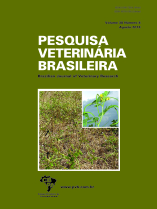 |
|
|
|
Year 2018 - Volume 38, Number 8
|

|
Myelodysplasia in feline infectious peritonitis: 16 cases (2000-2017), 38(8):1638-1648
|
ABSTRACT.- Luz F.S., Mazaro R.D., Lorensetti D.M., Kommers G.D., Flores M.M. & Fighera R.A. 2018. [Myelodysplasia in feline infectious peritonitis: 16 cases (2000-2017).] Mielodisplasia na peritonite infecciosa felina: 16 casos (2000-2017). Pesquisa Veterinária Brasileira 38(8):1638-1648. Departamento de Patologia, Universidade Federal de Santa Maria, Av. Roraima 1000, Santa Maria, RS 97105-900, Brazil. E-mail: anemiaveterinaria@yahoo.com.br
Although the prevalence of feline infectious peritonitis (FIP) is high worldwide, recent anatomopathological studies about this disease are scarce. Information on the microscopic characteristics of the bone marrow in FIP-affected cats are absent in the available literature. Based on this, the purpose of this article is to describe bone marrow lesions seen in spontaneous cases of FIP. The bone marrow collected systematically from the femoral diaphysis of 16 cats necropsied in the Laboratory of Veterinary Pathology (LPV) of the Federal University (UFSM) of Southern Brazil, between January 2000 and June 2017, with a definitive diagnosis of FIP, were evaluated phenotypically (histopathology - hematoxylin and eosin and histochemistry - Perls stain) and immunophenotypically (immunohistochemistry using myeloid - Anti‑MAC387, and lymphocytic - Anti-CD79 αcy and Anti-CD3 markers). Regardless the following was observed the clinicopathological form of the disease (“dry” - noneffusive or “wet” - effusive): 1) myeloid hyperplasia; 2) erythroid hipoplasia; 3) megakaryocytic dysplasia (dismegakaryocytopoiesis); and 4) medullary plasmacytosis. Exclusively in cases of “dry FIP” was bone marrow and hepatic hemosiderosis. These lesions allowed establishing that cats with FIP develop myelodysplasia, a myeloproliferative lesion very similar to that reported in HIV-infected humans. It is suggested that, based on the findings described here, myelodysplasia is considered to be the main cause of hematological abnormalities observed in FIP, especially for non-regenerative anemia and thrombocytopenia, frequently developed by patients. |
| |
|
|
| |
|
 |